23rd January 2008 : Birds, Skinks & Politics
 Monday, January 28, 2008 at 03:26PM
Monday, January 28, 2008 at 03:26PM New bird alert! After the initial bird-listing frenzy when I first began this journal, and was able to record ten or more new species every day, things have slowed down a bit, as most of the avian residents have now been spotted…but today, I was able to add the Pin-tailed Whydah, a diminutive and striking little bird, the male sporting a bright red beak, black and white feathers and a very long tail. The female, as often the case with birds (unlike humans, of course), is dull brown and indistinct. In fact, when he’s not in breeding plumage, the male also joins the ranks of the LBJs (‘Little Brown Jobs’) and may therefore have been here all along. Either way, at the minute, being seed-eaters, he and his missus are attracted by the seeding grass on the Hippo Lawn. Today, the Whydah was being blown every which way in the wind, as he perched on one of the spindly acacia tomasi branches, his tail being blown out horizontally behind him.(Our list of birds spotted at Kulafumbi now numbers a staggering 168 different species!)
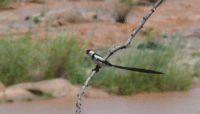
Male Pin-tailed Whydah being blowen in the wind
click any image to enlarge
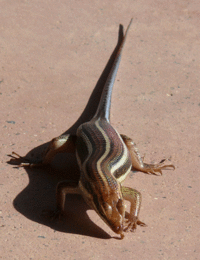
Female Rainbow Skink cleaning up the bugs...
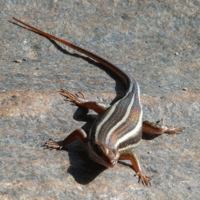
Living up to her name: irridescent in the sunlight
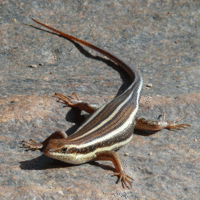
Unlike the males, the female and baby Rainbow Skinks are distinctly striped...
The Rainbow Skinks which have made themselves so at home in our house are so tame now, almost running right over our feet as we sit at the table on the balcony having breakfast. We really like having them around, and they’re quite useful for cleaning up the bugs too! The female skink was here this morning, with her striped body and blue-tinged tail. In the sunshine, her scales shone iridescent – yes, like a rainbow – in the light.
One of the ways I keep fit here in the bush is by working out on my trampoline (well, strictly speaking, it is a rebounder, according to the manufacturers – a trampoline is for playing, a rebounder is for working out…but it looks like a small trampoline to me! It’s a great bit of kit actually, and even better when, like today, I was bouncing happily away on our balcony, the whole of the Athi River spread out before me, when – just to put the icing on the cake – a hippo came out of the water right below me and wandered along ankle-deep by the reeds on the edge of the river. There’s a reason why we don’t have TV here!
The sad – but predictable – effect of the political shenanigans and over-sensational media reports emanating from here in Kenya, is that tourism has dropped 96% overnight – so state the Kenya Wildlife Service, who manage the National Parks here and have records of all visitors to the parks countrywide. With tourism being the most important revenue-earner in the country (alongside horticulture – flowers, vegetables, tea, coffee), there are no prizes for guessing what is going to happen to the economy.
More in Pictures:
[January's Wildlife Photographs - from small fry to big game...]
[Birds photographed in January 2008 at Kulafumbi]





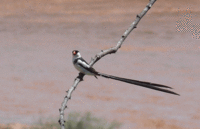
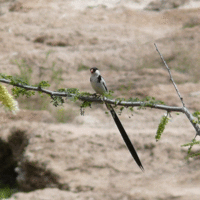
Reader Comments